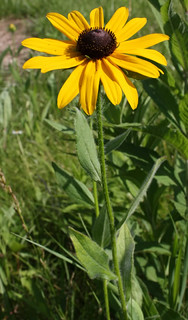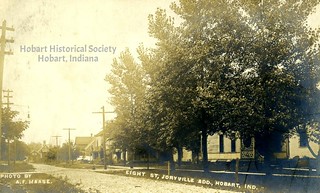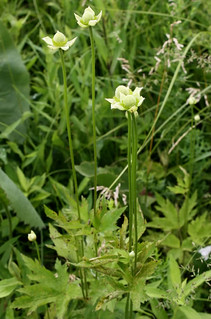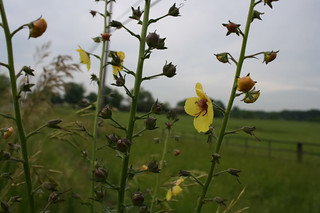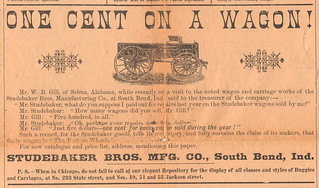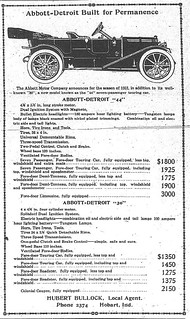After the local dairy farmers' initial difficulties in
organizing in 1901-2, and aside from the occasional
smallpox scare, their business seems to have gone along quietly for several years, with no more than ordinary troubles. Then in the summer of 1908, the progressive spirit of the times coupled with advances in medical understanding of the spread of disease to result in the passage of laws in Chicago and Indiana that had local farmers in an uproar.
Early that summer, the City Council of Chicago passed an ordinance, to take effect on January 1, 1909, that required milk sold in Chicago to come from dairy farms meeting certain standards of construction and operation; it also required that any milk sold, if sold unpasteurized, must come from cows that had been tested and found free of tuberculosis. And in July, the State of Indiana made it illegal to sell milk from diseased cows.
Local farmers had to take the Chicago ordinance as seriously as any Indiana law, since Chicago was their biggest market. And the Chicago Board of Health was sending agents to inspect northwest Indiana dairy farms and report on conditions they found. In anticipation of the effective date of the ordinance, many farmers started making the required improvements to their facilities, such as detaching cow stables from horse barns and whitewashing them, as well as to their procedures, such as cleaning the stable and thoroughly washing the cows' udders half an hour before each milking. All of this involved added time and expense for the farmers.
The tuberculin testing threatened further financial loss. The
Gazette was initially under the impression that until January 1 cattle testing positive for tuberculosis could still be shipped to Chicago for slaughter; but once the ordinance went into effect, "[t]he milk shipper or farmer owning cattle thus condemned must stand the loss. He cannot sell but must kill and bury."
Local farmers held a meeting in Ainsworth on Saturday, October 3, to discuss their dilemma. Faced with real and potential costs, they thought they should be compensated by a higher price for milk; but the milk dealers who sold to small retailers were insisting that they could not sell milk if the price were raised.
A second meeting at the Ainsworth schoolhouse on the evening of October 10 brought farmers in from miles around, about 250 of them. (How that little schoolhouse could hold 250 agitated people, I do not know — maybe they threw open the windows and doors so those who couldn't get in could hear what was going on, or maybe they all just met outside the school, under the starry skies.) Among the speakers at this meeting was John F. Dorman, who had once been "connected with the Health Department in Chicago" and whose brother, Charles, was on the Chicago police force.
The farmers decided that to protect their interests they had to form an organization to lobby the state government, primarily for compensation for cattle condemned by the tuberculin test. They began by electing officers: John Dorman, President; Calvin Shearer, Secretary; and Morgan Blachly, Treasurer. An Executive Committee, consisting of John Dorman, John Demmon and Cyrus E. Smith, was appointed to begin drawing up the organization's by-laws and drafting the desired legislation. The farmers chose Dr. Mike O'Hearn as the veterinarian who would inspect dairy cattle, and decided to demand $1.45 per can as their new minimum price for milk.
The next meeting, on October 16, drew some 300 farmers to Ainsworth. Several Chicago milk dealers addressed the assemblage. They pointed out that small milk dealers could not pay the $1.45-per-can price because the selling price for milk in Chicago was set by the large dealers; and if the small dealers were forced out of business, the dairy farmers would have to contend with the large dealers, effectively a monopoly.
John Green spoke up: he had tried to ship two cows to a Chicago slaughterhouse, but they were rejected by Illinois authorities as tubercular, and he received for them only the price of their hides. This seemed to negate the belief that tubercular cows could be sold in Chicago for meat before the new ordinance went into effect. (Under Indiana law at the time, the majority of cattle found to be infected with tuberculosis could be kept for breeding or sold for meat, subject to federal regulations on meat inspection; but cattle "showing advanced or generalized disease" were condemned, with the owner receiving only the value of the hide.)
State Senator Arthur J. Bowser attended this meeting. He spoke briefly, asking the farmers to let him know what sort of legislation they wanted him to pursue.
November came, and the milk shippers union's Milk Price Committee — which now consisted of equal numbers of milk shippers and dealers — failed for the first time in years to reach an agreement on price. Their meeting disbanded in frustration. The Richmond-Smith Co., as agents for most of the local shippers, decided to fulfill its contracts at the market prices, which ranged between $.05 and $.15 below what the farmers were asking.
As the weeks went by, farmers continued making improvements to their facilities, rebuilding sheds and barns, putting in new floors and otherwise cleaning up. And they began to have their herds tested for tuberculosis.
At a meeting in Ainsworth in mid-November, the farmers learned that the state had finally appropriated funds to help pay for the testing, the cost of which had previously come straight from their own pockets. The farmers now decided to accept the services of the state veterinarian, A.W. Bitting, and his assistants in administering the tuberculin test. (But Dr. Bitting advised them that the state funding was inadequate, and asked the farmers to chip in $.20 for each cow to be tested.) At this meeting, the farmers decided to have petitions printed up for presentation to the legislature in January, seeking reimbursement for condemned cattle.
As the testing of local dairy herds progressed, some surprising results emerged. For instance, of the 18 milch cows belonging to Hubert Bullock, 17 were found infected — and his herd had long been thought one of the finest in the area. In the face of such results, some farmers began to doubt the accuracy of the test; others declared they meant to quit dairy farming altogether.
December brought more testing and more bad news. Charles Ols had 12 out of 30 cows rejected; Ben Bodamer's little herd of eight lost two. Other farmers were luckier: George Lutz lost only one out of 14, John Gruel only 3 out of 41, and all of John Sievert's cows passed the test.
The
Gazette urged all farmers to sign the petitions for passage of a compensation law.
News came from Crown Point that two local veterinarians who conducted a postmortem on a couple of cattle rejected by state testers had found both animals healthy and free of disease. Some farmers became so distrustful of the state testers that they preferred to hire private veterinarians instead, thought the cost was five times as much.
The new year came, and Chicago's new ordinance went into effect. The
Gazette quoted a prominent New York pasteurization advocate, who maintained that "[a]ll other measures for municipal advance fade into insignificance in comparison" with the new law. However, it quickly became apparent that the new law had "not been put in full operation" just yet.
Around Ainsworth, cattle testing continued, and so did the losses. Although five farmers escaped without a single cow condemned, and several others — including James Chester, Robert Rossow, Henry Nolte and Jake Hallern — lost only one or two, Henry Chester lost nearly his entire herd: 45 out of 50 condemned, and several more "suspicious."
Week after week, the dairymen met at Ainsworth. On January 11, owners of some 1,500 cattle showed up, along with representatives of the Chicago milk dealers union, and attorney Joseph H. Conroy of Hammond, whose firm represented the dairy farmers. News had reached the area that some Chicago wholesale milk dealers were buying up tubercular cows, pasteurizing the milk they got from them and selling it in competition with milk from the tested and healthy herds. The local farmers felt that this was unfair competition, and passed a resolution calling on Chicago authorities to repeal all laws "now in force providing for the pasteurization of milk." Discussion continued on the matter of state legislation to compensate farmers for condemned cattle. A "legislation and finance" committee was selected to continue the lobbying work, consisting of John Dorman, John Gruel, Harve Carey, Joseph Schillo, William Springman, Henry Reimer and Calvin Shearer.
On February 12 the
Gazette announced that the proposed tuberculosis-testing compensation bill had been introduced in the Indiana legislature. And a petition signed by more than 500 dairymen, urging passage of the bill, had been sent to Senator Bowser.
That same day, the State Veterinarian, Dr. Bitting, held a public postmortem on three cattle that had tested positive for tuberculosis. This demonstration took place on Michael Foreman's farm just west of Ainsworth. The first cow to be slaughtered and autopsied had come from a Wheeler farmer's herd, and outwardly had appeared healthy, but Dr. Bitting's dissection soon turned up evidence of disease: a pus-filled gland in the neck. Another cow showed evidence of disease in the liver, among other places. The most striking case was a cow belonging to Hubert Bullock, which had appeared sickly even before testing. "The examination showed she was completely diseased," the
Gazette reported, "and the dissecting was simply nauseating. She was the limit." The demonstration seemed to have achieved its intended effect: persuading the farmers of the reliability of the tuberculin test and the reality of disease among their cows.
Early in February, five local farmers — John Gruel, Harve Carey, Z.H. Fifield, Calvin Shearer and Joseph Schillo — left for Indianapolis to lobby legislators for passage of the compensation law. They appeared twice before a House committee, to speak first on their own proposed bill and then on the bill drafted by Dr. Bitting. The committee combined the two to create a compromise bill, which was approved by the House the following day. The farmer-lobbyists returned home optimistic.
The
Gazette of February 26 printed the text of the proposed "tuberculin test bill," which had now become House Bill No. 345. Its provisions included compensation to the owner of any tubercular cow that was condemned, the amount to be determined by agreement of the state and the owner, or if the value exceeded $25 and they could not agree, then by three independent appraisers. An otherwise healthy animal that reacted to the tuberculin test could be kept for breeding purposes, and for dairy purposes if its milk was pasteurized before sale, but the state had the power to condemn any animal "showing physical evidence of tuberculosis."
The Indiana House of Representatives passed the tuberculin test bill on February 24; the Senate passed it on March 5; and after a few days' hesitation and some intensive lobbying by Rep. Edward Wickey, the newly elected Governor Thomas R. Marshall signed it into law.
Its passage had not been an easy victory, not the least because of infighting among farmers. One of the attorneys for the milk shippers explained:
We had a very hard fight in the State legislature, especially in the House of Representatives, as the dairymen from different parts of the state differed as to what the law should be, consequently, we had the Ft. Wayne Dairymen and the Evansville Dairymen fighting us all the time while the bill was in the House … [but] when it reached the Senate I succeeded in getting the dairymen all over the state to thinking the same way, and for that reason … we didn't have much trouble in getting the bill through the Senate."
But it was an important victory, said the
Gazette, "especially to those farmers of Ross township where the project started," because it demonstrated what the dairymen could do when they worked together.
At a celebratory meeting in Ainsworth on March 13, the officers of the dairymen's association asked for donations to help defray the $300 in expenses they had incurred in securing the passage of the bill.
Sources







